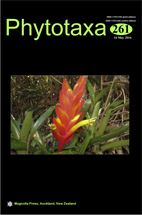Abstract
A new poroid genus with two conspicuous and common species growing on living Fabaceae trees is described from the Seasonally Dry Tropical Forests biome of Brazil. Both taxa in this forest pathogen genus resemble Phellinus rimosus macroscopically, but are distinguished by a dimitic hyphal system with skeletal hyphae present only in the trama of the tube layer while the context remains monomitic, and by the ellipsoid, thick-walled, adaxially flattened, yellow basidiospores that turn chestnut brown in KOH solution. Molecular and morphological studies of Brazilian specimens macroscopically similar to the Phellinus rimosus species complex were carried out to solve their phylogenetic relationships among the Hymenochaetaceae. Phellinotus gen. nov. with P. neoaridus sp. nov. as the genus type and P. piptadeniae comb. nov. are presented and described. Phylogenetically, Phellinotus is closely related to Arambarria, Inocutis, Fomitiporella and other taxonomically unresolved terminal clades, and unrelated to Fulvifomes and Phylloporia. Phellinotus and other genera of poroid Hymenochaetaceae that lack setae or setal hyphae and produce thick-walled, colored (pale yellow to rusty brown) basidiospores form a phylogenetic group here named the ‘phellinotus clade’. Our results indicate the need to include taxa from unexplored areas in order to get a thorough understanding of the phylogeny of the Hymenochaetaceae.

